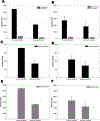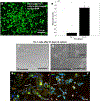3D Biofabrication of a Cardiac Tissue Construct for Sustained Longevity and Function
- PMID: 35533308
- PMCID: PMC9238347
- DOI: 10.1021/acsami.1c23883
3D Biofabrication of a Cardiac Tissue Construct for Sustained Longevity and Function
Abstract
In this study, we developed three-dimensional (3D) printed annular ring-like scaffolds of hydrogel (gelatin-alginate) constructs encapsulated with a mixture of human cardiac AC16 cardiomyocytes (CMs), fibroblasts (CFs), and microvascular endothelial cells (ECs) as cardiac organoid models in preparation for investigating the role of microgravity in cardiovascular disease initiation and development. We studied the mechanical properties of the acellular scaffolds and confirmed their cell compatibility as well as heterocellular coupling for cardiac tissue engineering. Rheological analysis performed on the acellular scaffolds showed the scaffolds to be elastogenic with elastic modulus within the range of a native in vivo heart tissue. The microstructural and physicochemical properties of the scaffolds analyzed through scanning electron microscopy (SEM) and Fourier transform infrared spectroscopy-attenuated total reflectance (ATR-FTIR) confirmed the mechanical and functional stability of the scaffolds for long-term use in in vitro cell culture studies. HL-1 cardiomyocytes bioprinted in these hydrogel scaffolds exhibited contractile functions over a sustained period of culture. Cell mixtures containing CMs, CFs, and ECs encapsulated within the 3D printed hydrogel scaffolds exhibited a significant increase in viability and proliferation over 21 days, as shown by flow cytometry analysis. Moreover, via the expression of specific cardiac biomarkers, cardiac-specific cell functionality was confirmed. Our study depicted the heterocellular cardiac cell interactions, which is extremely important for the maintenance of normal physiology of the cardiac wall in vivo and significantly increased over a period of 21 days in in vitro. This 3D bioprinted "cardiac organoid" model can be adopted to simulate cardiac environments in which cellular crosstalk in diseased pathologies like cardiac atrophy can be studied in vitro and can further be used for drug cytotoxicity screening or underlying disease mechanisms.
Keywords: 3D bioprinting; biofabrication; cardiac tissue-on-a-chip; heterocellular coupling; organoids.
Conflict of interest statement
Notes
The authors declare no competing financial interest.
Figures








Similar articles
-
3D-bioprinting of aortic valve interstitial cells: impact of hydrogel and printing parameters on cell viability.Biomed Mater. 2022 Nov 11;18(1). doi: 10.1088/1748-605X/ac9f91. Biomed Mater. 2022. PMID: 36322974
-
Tomographic volumetric bioprinting of heterocellular bone-like tissues in seconds.Acta Biomater. 2023 Jan 15;156:49-60. doi: 10.1016/j.actbio.2022.06.020. Epub 2022 Jun 16. Acta Biomater. 2023. PMID: 35718102
-
Contact guidance for cardiac tissue engineering using 3D bioprinted gelatin patterned hydrogel.Biofabrication. 2018 Jan 12;10(2):025003. doi: 10.1088/1758-5090/aaa15d. Biofabrication. 2018. PMID: 29235444
-
Advances in 3D Bioprinted Cardiac Tissue Using Stem Cell-Derived Cardiomyocytes.Stem Cells Transl Med. 2024 May 14;13(5):425-435. doi: 10.1093/stcltm/szae014. Stem Cells Transl Med. 2024. PMID: 38502194 Free PMC article. Review.
-
Bioprinting: Mechanical Stabilization and Reinforcement Strategies in Regenerative Medicine.Tissue Eng Part A. 2024 Jul;30(13-14):387-408. doi: 10.1089/ten.TEA.2023.0239. Epub 2024 Feb 9. Tissue Eng Part A. 2024. PMID: 38205634 Review.
Cited by
-
Advances of Engineered Hydrogel Organoids within the Stem Cell Field: A Systematic Review.Gels. 2022 Jun 15;8(6):379. doi: 10.3390/gels8060379. Gels. 2022. PMID: 35735722 Free PMC article. Review.
-
Advancing Cardiac Organoid Engineering Through Application of Biophysical Forces.IEEE Rev Biomed Eng. 2024 Dec 9;PP:10.1109/RBME.2024.3514378. doi: 10.1109/RBME.2024.3514378. Online ahead of print. IEEE Rev Biomed Eng. 2024. PMID: 40030454
-
Applications of 3D printing in aging.Int J Bioprint. 2023 Apr 11;9(4):732. doi: 10.18063/ijb.732. eCollection 2023. Int J Bioprint. 2023. PMID: 37323503 Free PMC article. Review.
-
Cardiac Tissue Engineering: A Journey from Scaffold Fabrication to In Vitro Characterization.Small Sci. 2024 Jul 22;4(9):2400079. doi: 10.1002/smsc.202400079. eCollection 2024 Sep. Small Sci. 2024. PMID: 40212070 Free PMC article.
-
3D cell culture model: From ground experiment to microgravity study.Front Bioeng Biotechnol. 2023 Mar 24;11:1136583. doi: 10.3389/fbioe.2023.1136583. eCollection 2023. Front Bioeng Biotechnol. 2023. PMID: 37034251 Free PMC article. Review.
References
-
- Murphy SV; Atala A 3D bioprinting of tissues and organs. Nat. Biotechnol. 2014, 32, 773–785. - PubMed
MeSH terms
Substances
Grants and funding
LinkOut - more resources
Full Text Sources
Miscellaneous

